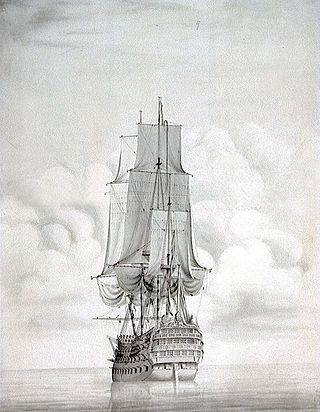
HMS Vanguard was a 90-gun second-rate ship of the line of the Royal Navy, built at Portsmouth Dockyard and launched in 1678.

HMS Royal Oak was a 74-gun third-rate ship of the line of the Royal Navy, built by Jonas Shish at Deptford and launched in 1674. She was one of only three Royal Navy ships to be equipped with the Rupertinoe naval gun. Life aboard her when cruising in the Mediterranean Sea in 1679 is described in the diary of Henry Teonge.

HMS London was a 90-gun second-rate ship of the line of the Royal Navy, launched on 24 May 1766 at Chatham Dockyard.

HMS Duke was a 90-gun second-rate ship of the line of the Royal Navy, launched on 13 June 1682 at Woolwich Dockyard.

HMS Charles was a 96-gun first-rate ship of the line of the Royal Navy, built by Christopher Pett at Deptford Dockyard until his death in March 1668, then completed by Jonas Shish after being launched in the same month. Her name was formally Charles the Second, but she was known simply as Charles, particularly after 1673 when the contemporary Royal Charles was launched.

HMS Falkland was a 50-gun fourth-rate ship of the line of the Royal Navy, built by Holland of New Castle, New Hampshire, and purchased by the navy in 1696.

HMS St Michael was a 90-gun second rate ship of the line of the Royal Navy, built by John Tippetts of Portsmouth Dockyard and launched in 1669.

The Prince Royal was a 55-gun royal ship of the English Royal Navy. It was later rebuilt and renamed HMS Resolution.

President was a 38-gun fourth rate frigate of the Royal Navy, originally built for the navy of the Commonwealth of England by Peter Pett I at Deptford Dockyard, and launched in 1650.
HMS Assistance was one of six 40-gun fourth-rate frigates, built for the Commonwealth of England under the 1650 Programme, after the Restoration of the monarchy in 1660 she was incorporated into the navy of the Kingdom of England. During her time in the Commonwealth Navy she partook in the First Anglo-Dutch war being present in the battles of Kentish Knock, Portland and The Gabbard. In the Mediterranean she was present at the Battle of Santa Cruz and the bombardment of Porto Farina, In the Second Anglo-Dutch War she was involved in the Battle of Lowestoft, Battle of Vagen and the St James Day Fight. She did not participate in fleet actions after this. She spent the rest of her service life undergoing several rebuilds and plying the waters as a cruiser protecting British trade and projecting British sovereignty. After nearly 95 years of Service she was sunk as a break water at Sheerness at the end of 1745.

Dunbar was a 64-gun second rate ship of the line of the English Royal Navy, originally built for the navy of the Commonwealth of England at Deptford, and launched in 1656. Renamed HMS Henry in 1660, she served until 1682, when she was lost in an accidental fire.
HMS Windsor Castle was a 90-gun second rate ship of the line of the English Royal Navy, built by Thomas Shish at Woolwich Dockyard, and launched in 1679.
HMS Duchess was a 90-gun second rate ship of the line of the Royal Navy, built by John Shish at Deptford Dockyard, and launched in May 1679.
HMS Albemarle was a 90-gun second rate ship of the line of the Royal Navy, launched on 29 October 1680 at Harwich.
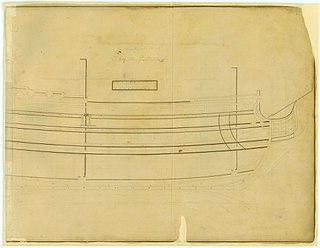
HMS Ossory was a 90-gun second rate ship of the line of the Royal Navy, launched on 24 August 1682 at Portsmouth Dockyard. She was renamed HMS Prince in 1705.
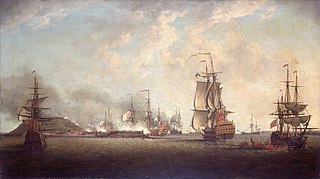
HMS Neptune was a 90-gun second-rate ship of the line of the Royal Navy. She was built under the 1677 "Thirty Great Ships" Programme and launched in 1683 at Deptford Dockyard.
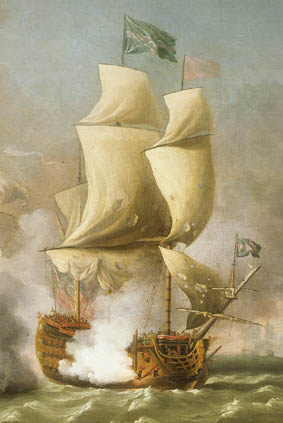
HMS Barfleur was a 90-gun second rate ship of the line of the Royal Navy, launched at Deptford Dockyard on 10 August 1697.
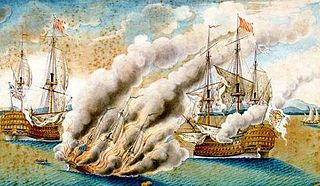
HMS Namur was a 90-gun second rate ship of the line of the Royal Navy, launched at Woolwich Dockyard in 1697.
HMS Triumph was a 90-gun second rate ship of the line of the Royal Navy, launched at Chatham Dockyard on 2 March 1697. She was renamed HMS Prince in 1714.
Six ships of the Royal Navy have borne the name HMS Sandwich, either after the English seaside town of Sandwich, or one of the holders of the title Earl of Sandwich, particularly Vice-Admiral Edward Montagu, 1st Earl of Sandwich, or First Lord of the Admiralty John Montagu, 4th Earl of Sandwich. A seventh ship was planned, but never completed:













